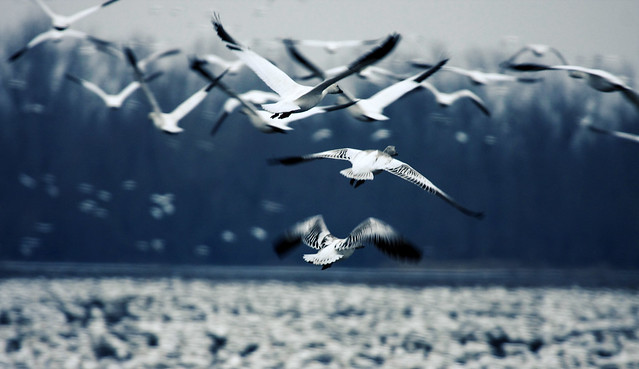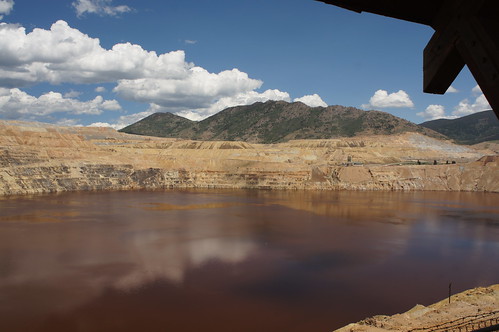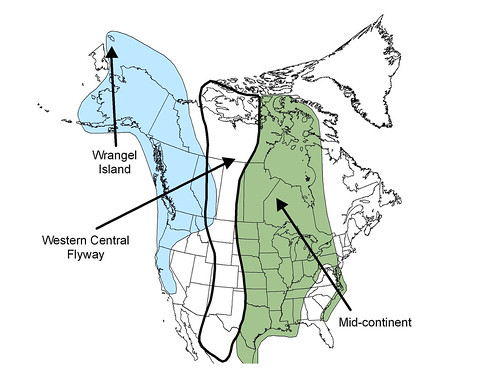Wildlife officials en route have no way to identify live birds exposed to toxic Berkeley Pit water in Montana
Every Halloween, birders gather at Montana’s Freezout Lake, about an hour’s drive from Great Falls. It’s an overwhelming spectacle: Up to 300,000 snow geese gather to rest after a night-long, nonstop flight of at least 400 miles from Alberta or Saskatchewan in Canada. After Freezout, there’s still about 1000 miles left before the snow geese reach their destination, the Sacramento Wildlife Refuge in California.

Photo by eflon/flickr
This year, the weather tricked tens of thousands of snow geese into delaying their flight south.
This year, the weather tricked tens of thousands of them — autumn was warm out West. They stayed up north a little too long. By the time the snow geese reached Freezout, the lake had lived up to its name. It had iced over. Exhausted and thirsty, the massive flock pressed on until they spotted what looked like a safe refuge. A little past dinnertime on November 28, the tired geese descended through a swirling snowstorm. They landed on the toxic soup that’s slowly filling the largest Superfund site in the United States: Butte, Montana’s Berkeley Pit, a massive hole in the ground that once used to be a copper mine.
The Pit is hard to miss. It’s a mile long, a half mile wide, and 1700 feet deep. The water in the Berkeley Pit covers 700 acres, a surface area about 4/5ths the size of New York City’s Central Park. It’s 900 feet deep, and getting deeper by the day.
Thousands of migrating geese perished in the Pit in the first few hours. Where is the rest of the flock of perhaps 8,000 birds? Did they survive? Did they die nearby, or farther down the Pacific Flyway? Is there a protocol to track critical incidents that might affect birds, animals or humans? How — and how quickly — did people react?
Birdwatching: 24/7, 365
“Employees tried urgently to keep the birds from landing,” said Mark Thompson, environmental affairs manager for Montana Resources, a company that, since 1985, has mined old tailings for copper and molybdenum, an element that’s used in glass furnace electrodes and in the petroleum industry. “Our manpower was out there all night.” Thompson paused to consider the sheer number of snow geese that overwhelmed their efforts. “The water was covered with white birds.” For the workers, Thompson said, the battle was personal. They were trying to save the birds, but they also were attempting to fend off another public relations disaster.
 Photo by PROTjflex2/FlickrThe Berkeley Pit, a former copper mine, where the snow geese landed in Late November, is filled with acidic water with high concentrations of heavy metals and toxic chemicals, including arsenic, cadmium, copper, zinc, sulfuric acid and molybdenum.
Photo by PROTjflex2/FlickrThe Berkeley Pit, a former copper mine, where the snow geese landed in Late November, is filled with acidic water with high concentrations of heavy metals and toxic chemicals, including arsenic, cadmium, copper, zinc, sulfuric acid and molybdenum.
 Photo by Claire BaizIn its heyday, Butte didn’t have a pit mine, and its iconic M&M
Photo by Claire BaizIn its heyday, Butte didn’t have a pit mine, and its iconic M&M
bar didn’t have a front door.
 Image courtesy of EPAEPA's chart of the Berkeley Pit's remediation status.
Image courtesy of EPAEPA's chart of the Berkeley Pit's remediation status.
 Map of snow geese range.
Map of snow geese range.
For further information log on website :
http://www.earthisland.org/journal/index.php/elist/eListRead/tens_of_thousands_of_snow_geese_dying_along_pacific_flyway
Every Halloween, birders gather at Montana’s Freezout Lake, about an hour’s drive from Great Falls. It’s an overwhelming spectacle: Up to 300,000 snow geese gather to rest after a night-long, nonstop flight of at least 400 miles from Alberta or Saskatchewan in Canada. After Freezout, there’s still about 1000 miles left before the snow geese reach their destination, the Sacramento Wildlife Refuge in California.

Photo by eflon/flickr
This year, the weather tricked tens of thousands of snow geese into delaying their flight south.
This year, the weather tricked tens of thousands of them — autumn was warm out West. They stayed up north a little too long. By the time the snow geese reached Freezout, the lake had lived up to its name. It had iced over. Exhausted and thirsty, the massive flock pressed on until they spotted what looked like a safe refuge. A little past dinnertime on November 28, the tired geese descended through a swirling snowstorm. They landed on the toxic soup that’s slowly filling the largest Superfund site in the United States: Butte, Montana’s Berkeley Pit, a massive hole in the ground that once used to be a copper mine.
The Pit is hard to miss. It’s a mile long, a half mile wide, and 1700 feet deep. The water in the Berkeley Pit covers 700 acres, a surface area about 4/5ths the size of New York City’s Central Park. It’s 900 feet deep, and getting deeper by the day.
Thousands of migrating geese perished in the Pit in the first few hours. Where is the rest of the flock of perhaps 8,000 birds? Did they survive? Did they die nearby, or farther down the Pacific Flyway? Is there a protocol to track critical incidents that might affect birds, animals or humans? How — and how quickly — did people react?
Birdwatching: 24/7, 365
“Employees tried urgently to keep the birds from landing,” said Mark Thompson, environmental affairs manager for Montana Resources, a company that, since 1985, has mined old tailings for copper and molybdenum, an element that’s used in glass furnace electrodes and in the petroleum industry. “Our manpower was out there all night.” Thompson paused to consider the sheer number of snow geese that overwhelmed their efforts. “The water was covered with white birds.” For the workers, Thompson said, the battle was personal. They were trying to save the birds, but they also were attempting to fend off another public relations disaster.
It’s not the first time migrating waterfowl have perished in the Pit. In 1995, after 342 migrating snow geese landed and died there, noisemakers called Phoenix Wailers, which alternate random mechanical and natural sounds at varying durations, were installed to frighten off birds. Since that incident, there’s been a cooperative effort to haze approaching flocks, 24 hours a day, seven days a week, year round. It’s worked pretty well — until now.
 Photo by PROTjflex2/FlickrThe Berkeley Pit, a former copper mine, where the snow geese landed in Late November, is filled with acidic water with high concentrations of heavy metals and toxic chemicals, including arsenic, cadmium, copper, zinc, sulfuric acid and molybdenum.
Photo by PROTjflex2/FlickrThe Berkeley Pit, a former copper mine, where the snow geese landed in Late November, is filled with acidic water with high concentrations of heavy metals and toxic chemicals, including arsenic, cadmium, copper, zinc, sulfuric acid and molybdenum.
“Animals habituate,” said Janet Ellis, senior director of policy for Montana Audubon. “Flock behavior probably gave the birds a sense of security, despite the hazing.” Exhaustion and extreme thirst contributed to this latest death toll on the Pit. The snowstorm didn’t help. Another factor may have been the absence of a boat. “Hazing waterfowl is more effective on the water than it is from the shoreline,” according to US Fish and Wildlife Service public affairs and contaminant specialist Ryan Moehring.
Moehring said the Consent Decree, a part of the Superfund Site requirements, mandates that a boat is maintained in the Berkeley Pit. Part of the Pit wall collapsed in 2012, causing a tidal wave that tossed the observation boat high up on the opposite shore. Fortunately, no one was on board. Unfortunately, Moehring said, it’s too dangerous to launch another watercraft in the Pit.
By all accounts, it was unsafe to retrieve the carcasses of dead geese unless they washed up on shore. Thousands of the birds were left on the Berkeley Pit to decompose. Given the Pit water has a pH of 2.5, it’s not taking very long.
Experts also agree that drinking Pit water killed thirsty birds fairly quickly. Geese that didn’t drink themselves to death may suffer a worse fate, according to Erick Greene, an ecotoxicologist at the college of forestry and conservation at the University of Montana in Missoula. The longer a bird was on the Pit, the more copper, arsenic, cadmium, molybdenum, zinc, sulfuric acid it absorbed. These toxins present in the water present a double-whammy, Greene explains. The forms of these metals found in the Pit water are very bio-available, which means the get absorbed by living bodies quickly. They also bioaccumulate, or build up, instead of being excreted. “I would not be surprised if all these geese died before reaching their destination,” Greene said.
Greene thinks some geese, depending on exposure, could have made it out of Montana and down the flyway. But Moehring thinks they all dropped near Butte. “That water is highly toxic. Birds exposed to it aren’t going to get very far.” Moehring, a trained conservationist, said, “Trans-state, it’s not a significant concern.” A few dead geese have been found around town. Two fell in the Walmart parking lot, another in front of a nearby casino.
That leaves many thousands of potential survivors, untraceable.
It’s a tragic death for these federally protected migratory game birds, who often mate for life. Snow geese travel in family units — mom, dad and the kids stay together for years at a time.
The Richest Hill on Earth
 Photo by Claire BaizIn its heyday, Butte didn’t have a pit mine, and its iconic M&M
Photo by Claire BaizIn its heyday, Butte didn’t have a pit mine, and its iconic M&Mbar didn’t have a front door.
Over the last century, Butte has seen its own migration. About a hundred years ago, the city’s population was 100,000. Today, it’s under 35,000.
In the early 1900s, Butte was damn sophisticated, drawing celebrity entertainers like Charlie Chaplin, Sarah Bernhardt and Mark Twain — but this was no polite metropolis. The M&M Cigar Store was one of dozens of bars. The infamous Dumas Brothel was only one the town’s houses of ill repute. Nearly fifty years ago, a Butte native and small-time huckster parlayed his fearless talent into a shortened lifetime of broken bones and worldwide fame as a stunt performer. Butte honors that dead daredevil with a four-day party every summer. They call it “Evel Knievel Days.”
In its heyday, Butte didn’t have a pit mine—and the M&M didn’t have a front door.
Mining took place in tunnels both deep and dangerous, while the M&M served up suds, solace and friendly wagers around the clock. Like Butte, this bar, which is still open for business, has seen its share of highs and lows. In Esquire magazine in 1970, beat poet Jack Kerouac described the highlife and lowlife, and pronounced Butte's M&M “the ideal bar.”
Butte people live hard, work hard, play hard…and sometimes, they die hard. A series of mine fires in Butte’s 10,000 miles of underground tunnels culminated in the June 1917 Speculator Mine disaster, where 168 miners lost their lives. Economic suffering and offshore competition compounded Butte’s woes: Copper production in Butte faltered until the Anaconda Copper Co. opened the Berkeley Pit in 1955. Anaconda operated the mine until 1977, when they sold out to Atlantic Richfield Co. (ARCO). Before ARCO ended mining in April 1982, about a billion tons of copper, silver, gold and other commercial and precious ores had been extracted from what had been “The Richest Hill on Earth.” Within 18 months, it was declared a Superfund Site.
A Tub of Trouble
No one can drain the Pit, but cleanup efforts have slowed the spigot. A treatment plan which captures and treats inflow has helped slow rising water. Montana Resources uses the treated effluent in their mining operations at the nearby Continental open-pit copper mine.
Joe Vranka, site supervisor for the Environmental Protection Agency, says they’re doing the best they can with what he called a “legacy mine” and a “complex 150-year-old situation.” When asked if there was an end in sight, Vranka, replied, “I hope so.”
Part of the EPA plan, according to Vranka, has been to wait until the Berkeley Pit water has risen to within 50 feet of the lowest point in Butte’s water table, then begin pumping. (The pit is at the lowest point of Butte's water table. Everything drains there, until the water reaches a critical level.) It’s hoped, when Pit water flows into the long-abandoned deep mine shafts, a lack of oxygen will help dissipate some of the impurities.
Right now, the Pit water is about a hundred feet below ‘critical level.’ Despite assurances from Montana Resources that they’ll use “all the water they can get” in the future, the EPA is supervising expansion of the Horseshoe Bend water treatment plant to clean up additional Pit water, just in case.
The water level at the Berkeley Pit, Butte’s basement drain, may reach the critical point around 2022-2023.
Geese in the Pit = Canaries in a Coal Mine?
In the days before air quality devices, underground miners carried canaries down mine shafts. A single bird struggling to breathe would send humans scurrying for clean air. For Butte, the 1995 incident was the first avian warning.
But solutions are slow in coming: this chart from the EPA website summarizes the status of cleanup process, after 31 years:
EPA
 Image courtesy of EPAEPA's chart of the Berkeley Pit's remediation status.
Image courtesy of EPAEPA's chart of the Berkeley Pit's remediation status.
Parties involved in the Superfund site include ARCO (part of British Petroleum), the EPA, the State of Montana’s Department of Environmental Quality, Montana Resources Co., USFWS, Montana FWP and the state’s Bureau of Mines. Add individuals, groups, and academicians who seek input, and there’s a large group of interested parties pondering the future of the Berkeley Pit.
On the Fly(way)
 Map of snow geese range.
Map of snow geese range.
For the birds that survived Butte, the next two logical rest stops were Malheur National Wildlife Refuge in Oregon or Utah’s Bear Lake. Last Friday, no one answered five phone calls made to Malheur. Howard Browers, biologist with Utah’s Bear River Migratory Bird Refuge, had not heard of the incident, either. “We’re 90 percent frozen up, though. Those geese would not be likely to rest here anyway. Usually, if there’s a problem, there’s a woman from the Wildlife Health Office in Bozeman, Montana who contacts us.”
The receptionist at the Sacramento Wildlife Refuge in Northern California, after hearing about the situation, said, “Wow. Let me connect you with…someone else.” On Monday, December 12, that person, Pam Bierce, an External Affairs spokesperson for FWS, called back. She’d not heard of the die-off in Butte either, but she gave me the phone number of Ryan Moehring, who had.
Moehring assured me that he briefed co-workers from all eight districts of the US Fish and Wildlife Service. “We have weekly calls,” Moehring said. Though he acknowledged there isn’t 100 percent participation in these conference calls, and he could not identify who was on the line, he did say that FWS had “a toxicologist, a biologist, and law enforcement up there…We collected birds and sent them to the National Wildlife Health Center for necropsies.”
Whether the birds made it out alive — or not — the snow goose migration in Montana is over.
If Greene, the ecotoxicologist, is right, tens of thousands of snow geese may have dropped from the skies and been consumed by predators, scavengers, opportunistic mammals, and perhaps human hunters and their families.
If Moehring is correct, most of the affected birds would have succumbed close to Butte.
We may never know.
Around Butte, as of December 14, only anecdotal reports of dead geese had been reported, and at least one of them, found near Dillon, Mont., may not have been part of the wayward flock. All that’s certain is that ten thousand (or more) of birds spent time on the Berkeley Pit, and several thousand died there. That leaves thousands of birds, dead or alive, somewhere out West.
Cooked Goose
If there’s any silver lining in this cloud of feathers and blood, it’s that snow geese populations are, if anything, too robust. This species, which thrives on farmed grain fields, has done real damage to wetland nesting areas. “I’ve seen over a million of them in one place,” Moehring said.
Affected geese don’t come with warning tags, but Montana Fish Wildlife and Parks did issue a news release on December 8, 10 days after the incident, asking local hunters to freeze their snow geese harvest until lab tests come in. Even then, results are likely to vary, bird-to-bird. (My suggestion is that a lightweight, permanent dye is kept at the ready to be poured onto the Berkeley Pit, to mark the bellies of birds that might land there in the future.)
It’s been more than two weeks since the incident and whether the geese wound up a few miles from Butte or far down the Flyway, if they died, they’ve already become some creature’s dinner. If they haven’t fallen, they might look safe to eat.
“A hunter might not be aware that he’s taken a sick bird,” Greene said, noting that sicker birds would probably be easier to shoot, and repeating his warning that heavy metals bioaccumulate. “I would not want to eat a cooked goose that had been in the Berkeley Pit.”
For further information log on website :
http://www.earthisland.org/journal/index.php/elist/eListRead/tens_of_thousands_of_snow_geese_dying_along_pacific_flyway





No comments:
Post a Comment